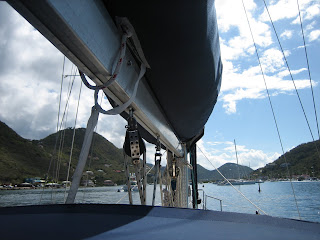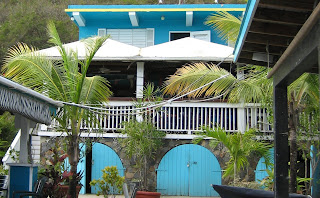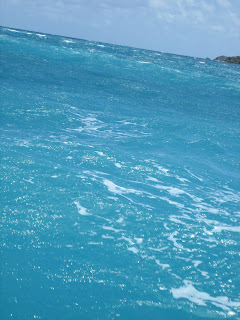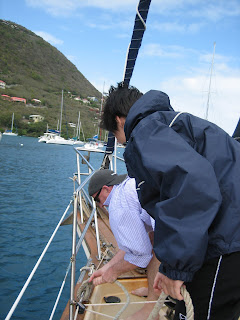
All quiet at the American Yacht Harbor in Red Hook. There was no clanging of halyards against the tall masts swaying over hulls and clouds reflected in the rippling water. Most sailors like it that way, they say, no matter how romantic some of us may find the sound. It’s a common courtesy where boats are homes away from home. Pull that halyard away from the mast, tie it back to a shroud, live and let live.
We felt ourselves on the edge of a new world, viewed through spars and hatches against the rising hills of St. Thomas and the neighboring islands. We exchanged smiles with our temporary home and teacher—a 40-foot Island Packet cutter-rigged sloop. She looked kind and strong, floating confidently along her full keel.
Ah but she was yar!
We felt ourselves on the edge of a new world, viewed through spars and hatches against the rising hills of St. Thomas and the neighboring islands. We exchanged smiles with our temporary home and teacher—a 40-foot Island Packet cutter-rigged sloop. She looked kind and strong, floating confidently along her full keel.
Ah but she was yar!


There was real Irish bacon and a proper sailor’s breakfast at Molly Molone’s. We took a rain-check on the blood sausage. Even if they’d been courteous enough to rename it Irish Pudding, we knew it for what it was. And, although half our crew had been born with British livers, we thought it best to delay the Guinness until after we’d earned it.
“When the gunwhales are awash, it’s the scuppers what keeps ‘em from swampin’”
“Aye!”
“OOAARRRH!”
Somehow every grade-B pirate film we’d ever seen worked its way into our hasty review of sailing jargon. We tore the boat joyously apart, locating safety equipment, exploring through-hulls, savoring the metallic stench of the rode, becoming familiar with every floating nook and cranny, from stem to stern. By the time we sailed out of Red Hook, the cockpit held no secrets. We just needed to learn how to ‘run the darn thing’…
“Aye!”
“OOAARRRH!”
Somehow every grade-B pirate film we’d ever seen worked its way into our hasty review of sailing jargon. We tore the boat joyously apart, locating safety equipment, exploring through-hulls, savoring the metallic stench of the rode, becoming familiar with every floating nook and cranny, from stem to stern. By the time we sailed out of Red Hook, the cockpit held no secrets. We just needed to learn how to ‘run the darn thing’…
Behind us, the picture postcard was full of masts and shops. Skies ahead looked more like the North Sea than what we’d imagined the Caribbean to be like. Still, you’ve got to allow paradise its own weather—it’s not quite Southern California.
We motored out of Red Hook Harbor into Pillsbury Sound, across a calm, windless sea that was just beginning to catch up with the roiling atmosphere above it. Once out of the protection of the harbor, we trimmed our sails and headed assuredly into rolling waves and a light rain. But as the rain started taking itself seriously, we faced the challenge of coordinating our own perception of apparent wind with the wise use of our instruments.
There was a first-time feeling of having your own immediate island beneath you. It was taking care of everyone on board, its full keel nestling naturally and securely into the waves it was born for.
We motored out of Red Hook Harbor into Pillsbury Sound, across a calm, windless sea that was just beginning to catch up with the roiling atmosphere above it. Once out of the protection of the harbor, we trimmed our sails and headed assuredly into rolling waves and a light rain. But as the rain started taking itself seriously, we faced the challenge of coordinating our own perception of apparent wind with the wise use of our instruments.
There was a first-time feeling of having your own immediate island beneath you. It was taking care of everyone on board, its full keel nestling naturally and securely into the waves it was born for.
Then it cleared up, completely; and we rounded St. John toward Norman Island—Robert Louis Stevenson’s Treasure Island inspiration. It looked a bit scrubby from where we sat bobbing leisurely, our palms stinging from doing first battle with winches and sheets. But the colors were pristine, and the snorkeling was more than refreshing. Even more significantly, the shark we saw also saw us, and circled twice.


We found nighttime cheer at Willy T’s--little more than a happy raft floating on the edge of a starry boat-village. They say it was quieter than usual when we got there. Nowhere to be seen were the customary bare-breasted bodies flinging themselves into dark waters made bright with alcohol. But there were plenty of smiling faces, and a place to park your dinghy alongside.


As we crossed St. Francis Drake Channel, from St. John to Tortola—America to Britain—there was another calm before the storm. Cloud shadows chasing across the land seemed much more playful than ominous.
Suddenly a squall blew up. A cold front out in the Atlantic off Cape Hatteras had sent 20 foot swells down to the Caribbean. We ran for rain gear, having too much fun to feel threatened. Our beloved Island Packet was still taking care as we set a course for the Beef Island promontory, at the eastern end of Tortola. But, although we fought so hard with wind and waves, we could make no headway.



Accepting where Nature wanted us to be, we retraced our wake back along Tortola toward the leeward side of the island. There we caught our first glimpse of the quiet luxury of Frenchman’s Cay. Some of the houses teased the shore, coming down as close as they dared in hurricane country (and then some). We picked up a mooring in Soper’s Hole—delighted to be able to do it on the first try—and ‘went through’ British customs by staying with the boat until our skipper cleared passports ashore.
Cap’n was a joyless European transplant—a mad relic whose saving graces were a prize-winning Paprikash, a fine nose for safety, and a speedy ‘way’ with customs officials. He seemed loathe to set bare foot on dry land, which probably accounted for his swift, sociopolitical skills.
When asked how he managed to do the long hauls—blue water sailing out in the great middle of the enormous sea—he replied, “Look out there.” The ancient mariner’s finger pointed to a far-off place where the Caribbean met the sky with no land in between. “From any one place, you can only see as far as the horizon anyway. So, what does it matter how far the water goes? All you can ever see is that much, so what’s the difference?”
He had a point there.
Cap’n was a joyless European transplant—a mad relic whose saving graces were a prize-winning Paprikash, a fine nose for safety, and a speedy ‘way’ with customs officials. He seemed loathe to set bare foot on dry land, which probably accounted for his swift, sociopolitical skills.
When asked how he managed to do the long hauls—blue water sailing out in the great middle of the enormous sea—he replied, “Look out there.” The ancient mariner’s finger pointed to a far-off place where the Caribbean met the sky with no land in between. “From any one place, you can only see as far as the horizon anyway. So, what does it matter how far the water goes? All you can ever see is that much, so what’s the difference?”
He had a point there.

We walked along the colorful edge of this fresh place. The American tourists snapped and shopped in shorts and T-shirts. The Euro-chic watched it all from the Lacoste-laden comfort of one or two outdoor cafés, while scavenging goats watched anything they could lay their eyes on. There was a simple elegance to all these candied façades.
I remembered old Cuban friends, immigrants with warm, brown eyes who had just arrived in the cold north from that big island that lay west of us now. “Why do you make all your buildings gray and brown?” they would ask, saddened and bewildered. No wonder; they came from a rainbow corner of the world.



Evening light managed to find us in some unexpected inlets on the island. The brackish waters had a Huck Finn quality about them—grandpa and Uncle Jeb angling for catfish, balancing precariously over their tackle. But is there really any catfish in paradise? Uncle Jeb says so, must be so.
We slept again under the stars, then awoke to the persistent thudding of our mooring ball against the forward hull—nowhere near as romantic as the soft clang of halyard on mast that we had guarded against so carefully. Too late to save ourselves from an early waking, we learned that our beloved Island Packet had the unusual habit, when moored or anchored, of turning broadside rather than bow to the wind. Her sideways quirk had tangled our mooring line just in time for us to catch a sailor’s dawn; so we ended up thanking her for the favor.


A broad channel called, with relative accuracy, The Narrows, separates British from American waters at the west end of Tortola. We sailed along the dotted line, beyond Great Thatch Island, toward Jost Van Dyke. The island’s very name conjures up images of 16th century explorers and periwigged scientists holding crudely polished lenses. In fact, it was named after the Dutch founder of the first settlements hereabouts—tobacco farmer and part-time pirate, Joost van Dijk. The island that bears his name was where he fled when the neighboring Spanish colonials had quite enough of his piracy.
Past Pull and Be Damn’ Point, we steered round and round the anchorage in Great Harbour. But alas, there was no room in the inn. Neighboring White Bay’s broad sandy beach looked inviting enough. We’d been warned not to get in too close with a ground swell rolling in. So we sailed carefully between the reefs and found a spot to drop anchor with plenty of scope, a bit further out.



We’d already caught that occasional glimpse of rickety, Caribbean splendor—just add color, string a few lights and baubles, then wait for the magic of sundown, for the full effect. But the vivid face of Jost Van Dyke that welcomed us went a little beyond. It was all the flavor and warmth of Africa that day, steeped in broad-daylight and humidity—a dusty but lush tropical lane down to an alluring hammock at the water’s edge; clinking ice in a refreshment worth its weight in gold; vendors whose cautious, then engaging smiles said ‘stay’; and, finally, warm nighttime waters bathing a world of trinkets and rum, with the faintest scent of ganja wafting by on the evening breeze. But beware the head-wrenching toxins—the litany of roosters that wake you at dawn will show no respect for your budding hangover.


We sailed out of White Bay bright and early, heading back toward American waters, to spend most of the day heaving-to, tacking, and jibing along the channel. Easterly winds well over the usual 15 to 20 knots had stirred up the sea-floor and brought bottom sand closer to the surface. There it caught the sunlight, and gave the deep water that special shade of aquamarine usually seen only in the shallows.
There’s a level of the sublime experienced in sailing that makes near-exhaustion exhilarating. Even if the body, at first, won’t respond to demands, it soon learns to. Even if hands and arms ache and twinge, at first, they soon learn not to. Sleep in a berth gently rocked by the sea can be the healer of all cares. And it may take a few days after you’ve returned to land for your bed to stop rocking, when you first open your eyes in the morning

Nothing further from the earthy hospitality of our brief encounter with Jost Van Dyke than the polished elegance of America’s own St. John. At first glance, we were convinced that the space between coconut palms, down on the beach at Caneel Bay, had been carefully measured by a Hollywood producer. Recreational equipment was stacked and arranged, never strewn. Outdoor walk-ins to designer public restrooms were stonewall-accented photo-art galleries with recessed lighting. And toddlers wore ensembles that would never be soiled.
Here both Mother Nature and Man had conspired to contrive a completely different brand of perfection. Wisely, I donned my own Lacoste crewneck to walk among the privileged.



Sweden gave the world the smorgasbord, stocked with meatballs, knackebrod, and all that wholesome, northern-latitude cooking that helps one to make it through to the next midnight sun. America dubbed it ‘buffet’; and with the hindsight of history, we now know that we made it so varied and generous that it caused many of our people to outgrow their own narrow economy seating on jet-liners, with an incalculable effect on fuel consumption across the nation.
Such a meal was brunch at the Caneel Bay Resort. We walked it off along the vereda tropical, through immaculately tended gardens and palm-groves basking happily in the cloudy glare, past bougainvillea-draped colonial ruins, and up, up to the hilltop dining hall where we could regale ourselves in yet another meal, later…later…we need but wish it so…






But our own floating island beckoned from far out in the bay. It was nothing like Bali Hai; there was no orchestral accompaniment rising exotically from the waves. In fact, Hollywood seemed to stop somewhere near the edge of the palm-grove below.
There was just a simple need to stand simply again, beneath the mast—and without the slightest trace of heroism, to let this wild and loving sea bring us home.




IF YOU GO:
On St. Thomas:
- Bluebeard’s Castle, http://www.bluebeardscastle.com/ , in Charlotte Amalie, for comfortable lodging and fine dining in luxurious surroundings.
- The American Yacht Harbor, http://www.igy-americanyachtharbor.com/ , in Red Hook, for sailing opportunities, the ferry to St. John is closeby.
On St. John:
- Caneel Bay Resort, http://www.caneelbay.com/ , “paradise as it was intended”; a converted Vanderbilt property offering garden walks and a broad range of activities and services, with frequent ferry connections to and from St. Thomas.
On Jost Van Dyke:
- Foxy’s, http://www.foxysbar.com/ , for entertainment and good cheer.
- Sydney’s Peace and Love ,www.jostvandyke.com/dining.html , for darned good cooking, particularly famous for its lobster.
On Norman Island:
- Willy T., http://www.williamthornton.com/ , try to catch it on a wild night.
On Tortola:
- Jolly Roger Restaurant and Hotel, www.bareboatsbvi.com/map_sopers_hole.html ; the ribs are great.
© Copyright 2008 by Cary Kamarat . All rights reserved.
Please share your travel experiences and impressions by clicking on the word ‘comments’ below. Alternatively, send your comments to the author directly at dinosasha@juno.com.
WATCH FOR NEW POSTINGS AT THE END OF EACH MONTH.


















